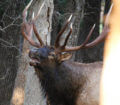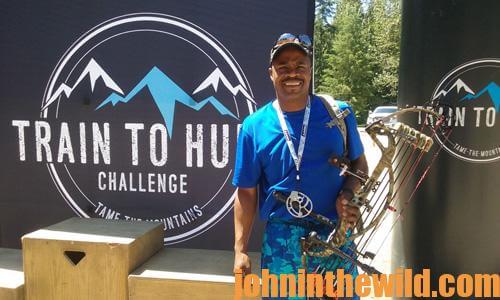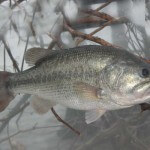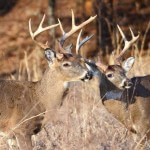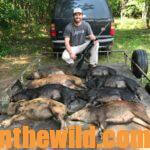Editor’s Note: Prior to the European settlement of the U.S., more than 10-million elk lived in most of the U.S. and parts of Canada. Today about 1-million elk live in the western U.S., Wisconsin, Michigan, Minnesota, Missouri, Pennsylvania, Arkansas, Kentucky, Tennessee, Virginia and North Carolina as well as sections of Canada. Elk live in a variety of habitats, from rain forests to alpine meadows and dry desert valleys to hardwood forests. Since elk season starts in some of these states in August, John in the Wild wanted to give you the latest information on preparing to hunt elk. Brian Mosley, from Bloomfield/Farmington, New Mexico, in the northwestern corner of New Mexico, says, “What I like about where I live is I’m 55 miles from Colorado, 1-1/2 to 2 hours from Utah and a 1 hour, 15 minute drive from Arizona. I can drive to any one of these states, hunt elk and drive home after the hunt. Plus, if I take an elk, I can get it back home quickly. Another advantage about where I live in New Mexico is in Colorado that has some of the most elk in the western states, I can buy an over-the-counter elk tag.” Mosley has been hunting elk for 17 years and has taken 15 elk – 98% of those with his bow. Mosley’s an avid elk hunter who’s a football and track coach, as well as a strength-and-conditioning coach.
I was hunting an untitled unit that didn’t have the number of elk that the titled units did in New Mexico that wasn’t far from my home. Later on in the morning, after hiking from daylight until about 10:30 am, I decided to sit down on a stump, eat a bagel and rest for a little while. Then I started blowing a cow call. This hunt was one of my first-ever elk hunts in the State of New Mexico, and I was trying to learn to hunt elk. I’m originally a whitetail hunter from Illinois. So, I was hunting then to learn the land and to practice blowing my elk call. I really wasn’t hunting elk. Since I had a mule deer tag and an elk tag, I was climbing up to the high country to look for a place to find a mule deer. I was totally frustrated, because I hadn’t seen any animals from before daylight until I decided to take a break. The last thing I expected to happen was to get a bull within bow range, since I wasn’t really seriously blowing the cow call. I was just trying to learn how to blow the cow call.
When I first saw this bull, he was at 44 yards. I was wearing Mossy Oak Brush (https://store.mossyoak.com/camo-patterns/brush), and I think the bull just thought I was some brush that had landed on top of the stump. I didn’t move, and the wind was in my face. So, the elk couldn’t smell me either – what I call, “A perfect God-given situation.” My bow was sitting across my lap, because the last thing I expected to happen during my lunch break was to have an opportunity to take a bull. The elk was moving slowly toward me. I picked up my bow and nocked an arrow. Before I’d eaten my bagel, I’d ranged several trees out in front of me and behind me. I’d thought a deer might wander in, and I wanted to be able to take the shot and know the distance I was from a deer.
Once the bull stepped between two trees that I had ranged at 28 yards, I mewed like a cow elk. But instead of looking at me, the bull looked the other way, presenting a broadside shot. I aimed right behind the bull’s shoulder and touched the trigger of my mechanical release. The broadhead went all the way through the bull and lodged in a tree 15 yards on his other side. At that time, I was shooting a Parker bow (www.parkerbows.com) and a Muzzy broadhead (www.muzzy.com). I watched the elk as he ran after taking the arrow and then fell.
 At that time, I didn’t have a frame pack. I was hunting by myself, and my truck was about a mile away. Because I’d never taken an elk, field dressing, skinning and quartering him was a real chore. I started field dressing the elk at about 11:15 am and didn’t finish field dressing, quartering and carrying the meat out until 7 pm. I carried that bull out in quarters, since I didn’t have any knowledge of deboning an elk.
At that time, I didn’t have a frame pack. I was hunting by myself, and my truck was about a mile away. Because I’d never taken an elk, field dressing, skinning and quartering him was a real chore. I started field dressing the elk at about 11:15 am and didn’t finish field dressing, quartering and carrying the meat out until 7 pm. I carried that bull out in quarters, since I didn’t have any knowledge of deboning an elk.
Today I generally hunt well away from my vehicle, so, I debone all the animals that I take to get the meat and the elk’s head out much quicker. Luckily once I’d loaded up this first elk, I still had enough daylight to get out of the woods and head back home. Even today that bull elk remains the biggest I’ve ever taken. He scored 356-3/8 on Pope and Young.
Equipment:
When I call to bulls, I use several different types of cow calls to sound like a herd of cows, instead of just one lonely, lonesome cow. One day I saw four different bulls coming to me. I’d set-up a Montana Decoy Company’s decoy (https://www.montanadecoy.com/), so that the bull’s attention would be focused on the decoy, instead of looking for me. I’ve found that when you hunt by yourself, you lose the advantage of having another hunter set-up behind you and trying to call the elk past you. So, I like to use a Montana Decoy Company’s cow elk decoy when I’m solo hunting for two reasons:
1) The bull elk will assume that the decoy is one of the cows that’s been calling to him, and he’ll be looking at the decoy as he comes in to calling.
2) The bull won’t be looking at me, if I’m sitting off to the other side of the decoy, and more than likely will give me a broadside shot.
The first bull I spotted was 180 yards from me, coming straight to the decoy. As I was watching that bull, I was listening to two more bulls bugle that were coming in from behind me, but I never heard the bull bugle that I took on this hunt. The bull came in to the right of me and gave a light grunt. I turned around, looked behind me and saw the silent bull looking at my decoy. I was on my knees. I knew I had to turn some to get a shot at this bull that was much closer than the other bulls. The bull jumped when he saw my movement. Then I mewed like a cow elk, and the bull stopped at about 40 yards. When I released my arrow, the bull wheeled, ran 30 yards and dropped. I thought I heard the bull fall, but I looked at my watch and decided to wait 35 minutes before I went to him. When I reached him, I saw the arrow had gone through one side of the bull, and the broadhead was stuck in the opposite shoulder.
I knew I would have a hard time skinning, deboning and getting that elk back to my truck that was 4-1/2 miles away. However, luck smiled on me. Another hunter had been hunting bears close by. We discovered that he was actually hunting in the wrong unit, because he’d gotten lost. He stayed with me, helped me debone the elk and helped me carry that elk the 4-1/2 miles out of the wilderness to my truck.
 I had 100 pounds of meat in my pack and the bull’s head, and the bear hunter put about 100 pounds of meat in his pack. We had to make many stops to rest before we reached my truck. At one of the stops when we both sat down on a log, we couldn’t get back up with our packs still attached to our backs, due to the great weight. So, we rocked back and forth until we were finally able to stand up. After exerting that much energy just to stand up, we decided we wouldn’t stop again, until we got to the truck. When we reached my truck, we saw his vehicle was parked right next to mine.
I had 100 pounds of meat in my pack and the bull’s head, and the bear hunter put about 100 pounds of meat in his pack. We had to make many stops to rest before we reached my truck. At one of the stops when we both sat down on a log, we couldn’t get back up with our packs still attached to our backs, due to the great weight. So, we rocked back and forth until we were finally able to stand up. After exerting that much energy just to stand up, we decided we wouldn’t stop again, until we got to the truck. When we reached my truck, we saw his vehicle was parked right next to mine.
This elk hunt for this 5×5 bull that scored 311 inches was the most grueling I ever remember. However, we were able to get all the meat out in one trip. After we got the meat and the head in my vehicle, I slept for about 1-1/2 hours before I returned to my campsite to break down my camp and carry it out.
To learn more about hunting elk by getting John E. Phillips’ Kindle, print and Audible books, go to http://amzn.to/17ENNqK. To get John and Denise Phillips’ free cookbook, “Miz Denise’s Outdoor Cooking: More than 35 Recipes for Elk and Mule Deer,” go to https://johninthewild.com/free-books.

